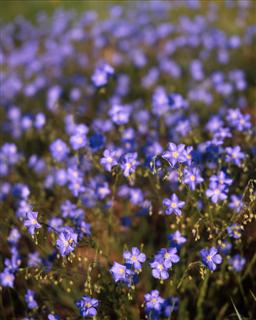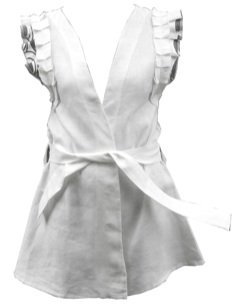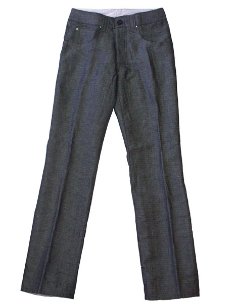Organic Linen Clothing
For That Light, Fresh Feeling
If comfort is your desire, then linen clothing will definitely bring satisfaction with it's soft, lightweight breeziness.

Linen is the grandaddy of all natural fibers.
Linen textiles may be the oldest in the world - flax linen wrappings have been found perfectly preserved in tombs after more than 3000 years.
Linen was highly valued since it represented wealth, and was even used as currency in ancient Egypt.
Linen Unraveled
What does "linen" really mean? The word "linen" originally referred to fabric and yarn derived from the flax plant.
Nowadays, the term is commonly and generically used to describe woven textiles (ie: sheets, towels, tablecloths and bedding.
To add to the "linen" confusion, other fibers such as
organic hemp
and
bamboo
are often improperly referred to as linen. Linen really means textiles made from the flax plant.
What Is Organic Linen?
Organic linen is produced from the plant fibers of flax crops that have been grown without the use of toxic fertilizer and pesticides.
Being one of the strongest vegetable fibers, flax linen has 2 to 3 times the strength of cotton. Line fibers (longer) are used for finer fabrics while tow fibers (shorter) are used for coarser fabrics. The natural color ranges with shades of tan, ecru, ivory, and gray.
Linen Fabric Characteristics
Thickness characteristics of flax fiber can create linen fabric with a textured feel anywhere from rough and stiff to soft and smooth.
Linen clothing is unrivaled in it's comfort because it feels light, fresh and cool. Because the fabric billows away from the skin it's feels refreshing so it's perfect for warm summer months.
Created from organic fiber without heavy metal dyes, natural linen is luxurious and elegant and can be designed into laid back, yet classy shirts, pants, dresses, skirts and suits for men and women.
Designers have unlimited potential with this down-to-earth fabric that goes far beyond the finest table linens to the most chic fashions. Look for organic linen clothing production to become more visible in the marketplace.
Benefits of Linen Fiber
 Highly absorbentGood heat conductorFeels cool to the touchSmooth and lint freeSoftens more with washingsHigh natural lusterDries quicklyAbility to wick moistureUnlikely to stick to the skinFabric is stronger wet than dryDoes not stretch Resists abrasion damageHas low elasticity, therefore keeps it's shapeResists dirt and stainsNo pilling or lint tendenciesAllergy freeAnti-static and antibacterialElegant and durable
Highly absorbentGood heat conductorFeels cool to the touchSmooth and lint freeSoftens more with washingsHigh natural lusterDries quicklyAbility to wick moistureUnlikely to stick to the skinFabric is stronger wet than dryDoes not stretch Resists abrasion damageHas low elasticity, therefore keeps it's shapeResists dirt and stainsNo pilling or lint tendenciesAllergy freeAnti-static and antibacterialElegant and durable
Disadvantages of Organic Linen Fabric
- Constant creases in the same place tends to break the fibers (ie: collars and hems)
- Wrinkles easily because of poor elasticity
- More expensive than cotton
- Moderate shrinkage
- Small knots (slubs) may appear which are actually quality defects
Linen Clothing Care
As always, read the care label first. Repeated washings makes linen softer and eventually reduces wrinkling. Linen fabric can be dry cleaned but it's not necessary (unless it's a suit).
- Just hand wash or machine wash on gentle cycle.
- Wash whites in warmer water and colors in cool water, using a biodegradable detergent.
- Do not use bleach as it will damage linen fibers.
- Hang or lay flat to dry. Avoid tumble drying.
- Iron while the garment is still damp to guard against burning the fabric. It's a good idea to iron the inside first to remove wrinkles, then do the outside to create a sheen. Avoid ironing dark colors on the outside.
- Store hanging is preferable rather than folded.
Environmental Benefits
 Conventional flax crops are used mainly for industrial purposes, but organic flax growing has boomed. This is largely due to the natural health benefits associated with eating flax seeds and oils.
Conventional flax crops are used mainly for industrial purposes, but organic flax growing has boomed. This is largely due to the natural health benefits associated with eating flax seeds and oils.
However, a greater number of consumers request organic flax for their linen clothing. Because demand far exceeds the current supply, organic flax crops have huge potential.
This demand will continue to make flax fiber production instrumental in providing widespread environmental and economical sustainability.
Organic production can be challenging for the grower. Even though crop rotation methods are used, flax is poor competition for weeds, which often results in higher production costs.
Aside from the many other health and industrial uses, flax fibers have a lot to offer the clothing industry. Presently, the downside is that 100% organic linen clothes are rather hard to find.
The good news is that organic linen fabric is a hot commodity.
With designers scrambling for organic and eco fabrics, and more consumers searching for healthier clothing alternatives, there's no doubt the future will bring us a greater selection of organic linen clothing.
Care What You Wear...
Great Shopping!
More Eco Chic Resources
Return from Linen Clothing to Home Page